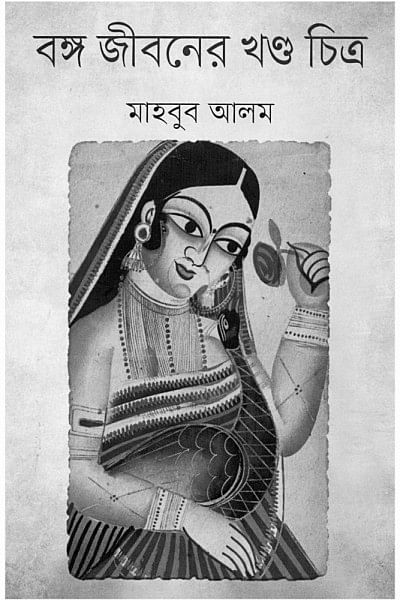Portraits of Bengali Life in a Bygone Era

Light, heavy, or both? History offers the reader a choice among all three, or a combination of them. To the aficionado, going through the works of the German classicist and minor politician Christian Matthias Theodor Mommsen (the second winner of the Nobel Prize for Literature; as the discerning will know, historians too have been honoured with this prize), like his monumental A History of Rome, might seem like attaining nirvana. Others might find the less ponderous six-volume The Second World War by Winston Churchill (another historian Nobel Laureate, and a major political figure in global history) more refreshing. Still others might choose to give those tomes and their ilk a wide birth, and settle for some comparatively lighter perusal of history and its offerings. Mahabub Alam, a Dhaka University History department alum and former career ambassador of Bangladesh, has written just such a book: Banga Jiboner Khanda Chitra.
And it is a kind of people's history of Bengal, elucidating the lives of the people of this region of a bygone era. The author declares in the Preface that he has written about the social life of ordinary Bengalis of the vanished era, and has shunned from providing any account of the lives of kings and nobles. Eleven essays make up this slim volume of 120 pages, and they deal with a variety of subjects: mothers-in-law, sweetmeat, pathshala, satire and cartoon, mango, lexicon, Bangla New Year, travel, and fish, predominantly the Ilish, almost certainly Alam's ultimate gastronomic delight, considering that he has devoted not one, not two, but three entire essays, wholly or partially, to this particular fish!
So on to the fish stories. The Ilish, which the author portrays as having an almost mystical connection to the Bengali palate. Here is a fish that is an ocean-dweller and that swims to sweet water rivers to spawn (much like the salmon). The ilish, or hilsa in the Anglicized form, seems to have a cousin in the Atlantic Ocean, shad, which tastes distinctly of the sea. If the mango has a mystical, supra-emotional hold on Bengali (indeed, many in the Indian sub-continent), then fish-and-rice seems to have a functional, existential grip on the people of this region (macche-bhate Bangali). Yet, as the author points out, the English consume, on an average per person, 49 pounds of fish a year, the Danes 24 pounds; the Chinese and the Japanese also chow down a hefty amount, but the Bengalis eat just 9 pounds! Still, the fish seems to have an umbilical association with the Bengali. Now, that is a mystical tie!
Alam is mystified at the complete silence, or only a passing reference, to the ilish in the literary output of some of the great Bengali writers: Ishwar Gupta, Bankim Chandra Chattopadhaya, Rabindranath Tagore, Jibananda Das, among others. But he is more incensed that the British, who won the Battle of Plassey and who subsequently ruled over the whole of India, could not conquer the ilish. More to the point, they were terrified of its myriad bones, and so stayed away from the devilish ilish, preferring to eat prawns, lobsters, and relatively boneless sea fish. Just imagine the one glowing light in the otherwise dark centuries of colonial rule: the defeat of the mighty English at the hands of the mightier ilish, and yet no appreciation of the fish in the writings of the great literary figures! They too must also have been put off by those hellish ilish bones!
Still on the subject of food, and to the mango. That essay is a veritable homage to that fruit. It is made out to be a repast of the gods, at least to the Bengali palate, as well as to that of many from the sub-continent. Alam gives a painstaking account of the varieties of mango that have flourished in Bengal, many named after the local nobility who patronized them. He finds some truth in the popular lore that the Nawabs of Bengal ruined themselves by an excessive obsession with everything mango (why, some varieties had to be laid out on the softest of cotton and looked after by a horde of attendants specially recruited for that job!). On another note related to the mango, Alam draws a poignant lesson in Bengal's fortunes: this region lost its independence in the mango grove of Plassey, but a bit over two hundred years later, gained back its independence at Meherpur/Mujibnagar's mango grove of Vaidyanath.
The mother-in-law (of brides) syndrome of yesteryears finds similarities, though on a reduced scale, with that of the Internet Age. Then it was pretty bad for the daughter-in-law --- sometimes very bad. The hostility faced by the new bride from almost the moment she set foot in her husband's premises at the hands of her mother-in-law and sister(s)-in-law was acute. In 1892, a British Raj court punished a mother-in-law for mistreating her daughter-in-law. That, however, did not stop such routine abuse. The author notes that, like then, the law has not been able to put a halt to daughter-in-law abuse even today. This essay also chronicles the rise of the dowry demand specifically related to Bengali men getting an education in the English curriculum and landing government jobs. This is an instructive piece. The author believes that quarrels over dowry at wedding ceremonies began in that period.
Now, back to food. And the sublime roshogolla. It really has a relatively recent origin as certain religious restrictions in the Hindu religion proscribed certain ways of processing milk. Only when Bengalis were introduced to modern education and gradually moved away from rigid conservatism did the roshogolla make its regal appearance to soothe the Bengali palate. It is a creation during the British Raj, when it also became very popular, though not so much with the British, who had named it "snow-ball." True to a general Bengali penchant for resorting to contention for contention's sake, and throwing unnecessary spanners into works, a number of them disputed, and continues to, that the spongy roshogolla was the brainchild of Nabinchandra Das (the author adorns him with the epithet "Columbus of Roshoglla") of Baghbazaar in 1868. Alam posits this line of thinking. Others have offered other creators, including from other parts of India, and even Portugal. However, cheese by no means is the roshogolla!
The essay on Pathshala is both inspiring and disturbing. While it did not discriminate in terms of colour, religion, or wealth while admitting students, and needs to be applauded even at this distance in time, the bewildering variety of corporeal punishments its teaching faculty meted out to erring students would probably send its perpetrators to the prison for inhumanity. The list of punishments cited would suit a seasoned practitioner of calisthenics or gymnastics. And one can only conjecture on how many of them suffered long-term or permanent physical damage, not to speak of mental disturbance.
We come to know from one essay that the art of satire and cartoon was learnt in the 1870s by the Bengalis from the famed London periodical Punch. The very word "cartoon" was first used in Punch. The wit and humour displayed in that periodical were the basis of replication by, first, English expatriates in India, and then by the Indians themselves. The English expatriates first published "Indian Charivari," creating the cartoon "Babu's Progress," which satirized educated Bengalis. Yet, as Alam points out, these Bengalis were the creation of the British Raj. Charivari's motto was a good one: "Less is more." Eventually, the Bengalis themselves took to self-deprecating humour, although, at times, they resorted to vicious mudslinging at each other. On another thoughtful note, Alam comments that several of the anomalies that the Bengali cartoonists had so wittily identified more than a century back continue to plague the society even now.
Bengalis have taken to tourism relatively late, but, irrespective of being Hindu or Muslim, they had gone on religious pilgrimages since olden times. The author closes with a piece on Bengali New Year and the iconic Halkhata. The Halkhata reached the height of its glory during the heydays of the zamindars, and the author believes that it will continue to endure for some time yet in the digital era.
I hope quite a few readers would find it worthwhile to eke out some time and go through Banga Jiboner Khanda Chitra. The journey back is quite often entertaining.
Shahid Alam is an actor and professor and Head, Media and Communication Department, IUB.

 For all latest news, follow The Daily Star's Google News channel.
For all latest news, follow The Daily Star's Google News channel. 



Comments